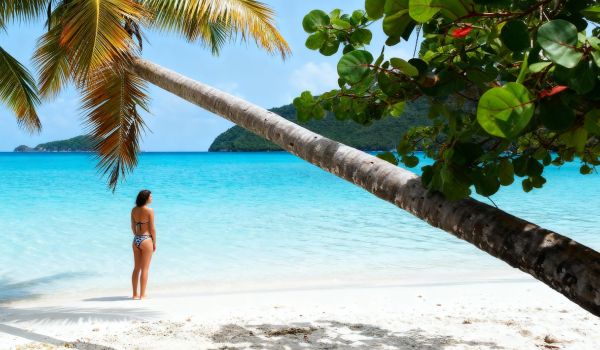Livingborderlessly
Archives
U.S. Virgin Islands (USVI): An Easy-Going American Paradise
SIGN UP FOR OUR NEWSLETTER
The U.S. Virgin Islands Vibe: Why America's Easy-Going Paradise is More Vital Than Ever |
Beyond the postcard-perfect beaches, St. Thomas, St. John, and St. Croix offer a rich tapestry of culture, history, and raw nature, all without needing a passport. Here’s a deep dive into the enduring soul of the USVI. |
There is a place in the Caribbean where your U.S. dollar is the only currency you need, where English is the lingua franca, and where your passport can stay tucked away at home.
This is the singular promise of the U.S. Virgin Islands (USVI), an archipelago of sun-drenched islands that feels both distinctly American and thrillingly exotic.
It's often called an "easy-going American paradise," but that simple phrase barely scratches the surface of what makes this territory so compelling.
The true magic of the USVI lies in its diversity—a collection of three main islands, each with its own rhythm, its own story, and its own unique claim on the traveler's heart.
The current momentum is undeniable, with tourism flourishing and accessibility growing.
Reports from mid-2025 show strong gains in cruise arrivals and hotel occupancy, reinforcing the islands' status as a premier Caribbean destination.
Expanded air service, including new routes from cities like Dallas, Chicago, and Boston, makes reaching this paradise easier than ever.
This isn't just one vacation; it's three distinct experiences woven into one effortless island-hopping adventure.
St. Thomas: The Bustling Heart of Commerce and Luxury
Your journey likely begins in St. Thomas, the most cosmopolitan of the islands and home to the territorial capital, Charlotte Amalie.
The harbor here is legendary, a deepwater port bustling with colossal cruise ships and sleek megayachts that glitter in the sun.
This is the epicenter of duty-free shopping, where historic Danish alleyways are lined with luxury boutiques selling jewelry, electronics, and spirits.
Significant revitalization efforts are underway to enhance this historic charm, with multi-phase projects like the Historic Area Revitalization Project (HARP) restoring 13 key properties along the waterfront, promising to transform the harbor front by 2029.
But to define St. Thomas solely by its commerce would be a mistake.
Venture beyond the town, and you'll find world-famous beaches like the stunning crescent of Magens Bay, consistently ranked among the most beautiful in the world.
The energy here is palpable, a vibrant mix of worldly visitors and proud locals who share their home with an open, welcoming spirit.
The island offers a dynamic social scene, from beachfront bars with live music to fine dining restaurants overlooking the twinkling lights of the harbor.
St. John: A Sanctuary of Untouched Nature
A short, scenic ferry ride from St. Thomas delivers you to another world entirely: St. John.
This is where the Caribbean's wild heart still beats loudly.
More than two-thirds of this breathtaking island is protected as the Virgin Islands National Park, a legacy of conservation that has preserved its forests, hills, and coastlines for generations.
The result is an island that feels profoundly undeveloped and serene.
Here, the main attractions are God-given.
Hike winding trails through lush greenery to discover historic sugar plantation ruins and ancient Taino petroglyphs.
Snorkel the famed underwater trail at Trunk Bay, where vibrant coral and schools of tropical fish create a mesmerizing spectacle just feet from the shore.
Explore secluded coves like Maho Bay or Honeymoon Beach, where the only sounds are the gentle lapping of waves and the rustle of palm fronds.
The small town of Cruz Bay serves as the island's charmingly low-key hub, with colorful shops and open-air restaurants that invite you to slow down and savor the moment.
Recent developments, including the public reopening of the iconic Caneel Bay Beach, ensure that access to these natural wonders is expanding thoughtfully and safely.
St. Croix: Where History and Culture Run Deep
The largest of the three islands, St. Croix, offers yet another profound shift in tone.
Known affectionately as "the Big Island," St. Croix is a place of deep historical roots and vibrant, living culture.
Its two main towns, Christiansted and Frederiksted, are architectural gems, their streets lined with pastel-hued Danish colonial buildings and historic forts.
Walking through the Christiansted National Historic Site, you can almost feel the echoes of a complex past shaped by sugar, rum, and the seven different flags that have flown over the island.
This is an island with a complicated and powerful history, and it doesn't shy away from it.
You can explore restored sugar mills, learn about the legacy of enslavement and emancipation, and understand the forces that shaped modern Crucian life.
That culture is on full display today, from its celebrated culinary scene—a fusion of Caribbean, African, and European influences—to its vibrant festivals like the Crucian Christmas Festival.
Beyond the towns, St. Croix's landscape is diverse, from the lush rainforest of the west end to the arid, cactus-studded east end, home to Point Udall, the easternmost point of the United States.
And just off its coast lies a national treasure: the Buck Island Reef National Monument, a protected marine park offering some of the most spectacular snorkeling in the Caribbean.
The Effortless Island Hop
What truly elevates the U.S. Virgin Islands (USVI) experience is the ease of moving between these unique worlds.
Reliable passenger ferries and car barges connect St. Thomas and St. John, making a day trip or a split-stay vacation incredibly simple.
A small seaplane or a dedicated ferry service connects St. Thomas to the more distant St. Croix, offering a breathtakingly scenic journey over turquoise waters.
This accessibility is the cornerstone of the USVI appeal—a reality that sets it apart from nearly every other Caribbean destination for American travelers.
There are no currency exchanges to worry about, no international phone plans to activate, and no immigration lines to endure upon your return to the mainland.
It is the perfect blend of adventure and convenience, allowing you to fully immerse yourself in the laid-back rhythm of island life without the logistical headaches of international travel.
Whether you seek the vibrant energy of St. Thomas, the profound tranquility of St. John, or the rich historical soul of St. Croix, the USVI delivers.
It is more than just a collection of beautiful beaches; it is a vital, dynamic, and deeply American corner of the Caribbean, waiting to be explored.
Frequently Asked Questions
Do I really not need a passport for the U.S. Virgin Islands?
That is correct. If you are a U.S. citizen, you do not need a passport to travel to the U.S. Virgin Islands, as it is a U.S. territory. You will still need a government-issued photo ID, such as a driver's license, for air travel.
What is the best way to get between St. Thomas, St. John, and St. Croix?
Getting between St. Thomas and St. John is very easy via passenger ferry from Red Hook or Charlotte Amalie, or by car barge from Red Hook. To travel to St. Croix from the other islands, you can take a regional flight, a seaplane for a more scenic experience, or a longer passenger ferry.
Is the USVI a good destination for more than just beaches?
Absolutely. While the beaches and snorkeling are world-class, the U.S. Virgin Islands offer incredible diversity. You can delve into colonial history and architecture in St. Croix, hike through a protected national park in St. John, and enjoy world-class shopping and dining in St. Thomas. The cultural festivals, historic sites, and diverse landscapes make it a rich destination for all types of travelers. |

